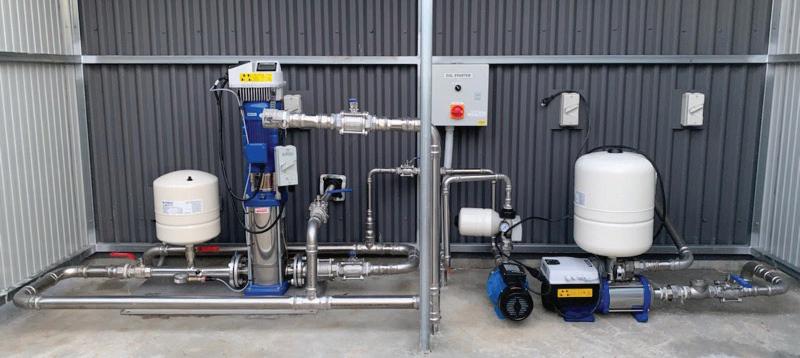
4 minute read
Pumping system supplies farm’s water needs
SNAPSHOT
• Project specifies four pumps for irrigation, stock and domestic supply • Farm plan requires use of groundwater and exclusion of stock from the river and riparian zone, which is treated as a conservation area • Groundwater is pumped into a holding tanks and then distributed for irrigation and domestic and stock use • After a year the pumps are running as designed and energy bills are lower than expected.
After buying a 16 ha farm near Eildon in Victoria that had a semi-established truffle orchard of 980 English oak and stone pine trees, Jamie Crowe, who also owns Melbourne-based JWC Plumbing, realised that there was some work to be done to ensure that the trees had access to irrigation water.
Early stages of groundworks to facilitate new irrigation lines. As well, water was needed to supply stock and domestic needs.
While the simple option would have been to source water from the river that the farm fronted and to which it had riparian rights, Jamie decided that fundamental to his property strategy was that he would not use river water or allow stock into the riparian zone.
Rather, he made a conscious decision not to draw water from the river but to leave it in its natural state, which was as a significant natural habitat for many species of animals and plants.
After investigation, a groundwater source that could supply the 6 ML a year needed was found on the farm. The water was at a depth of 75 m and was of drinking water quality.
The task for dealer Yves Gur from Idrill Ipump and Jamie was to set up a pumping system that efficiently and reliably supplied water for irrigation as well as for stock and domestic use.
Water challenges are escalating around the globe, placing people and communities, our environment, and our very future at risk. By 2025, 1.8 billion people will be living in countries or regions with absolute water scarcity. We are a Fortune 1000 global water technology provider with one mission: to help our customers solve water through the power of technology and expertise. Together, we can make water more accessible and affordable, and communities more resilient. Let’s create a world that is more water-secure and sustainable for all. We have the opportunity of a lifetime to solve water. Let’s work together and lead the way.
#LetsSolveWater


Water is pumped from a bore to the 250,000 L holding tank and then transferred for all irrigation and stock and domestic requirements.
Pumps selected to suit supply needs
The project required that several different pumps be installed.
The first pump was to take water from the bore into a 250,000 L holding tank that was to be used as a supply for irrigation and stock and domestic uses. A transfer pump was then needed to take water to the plantation irrigation system 400 m from the tank.
A Lowara bore pump acting on a float control was suggested for the bore, and a vertical, multi-stage booster pump for transferring water from the tank to the irrigation system.
The variable-speed-drive booster pump has more than enough pressure to supply 300+ small sprinkler heads at one time in the truffle plantation, as well as provide water for domestic garden irrigation. It is under constant pressure to the irrigation solenoids that are activated by a controller programmed with pre-set run times.
The controller has Wi-Fi ability so the whole system can be activated from Jamie’s phone, no matter where he is or if a dry period is encountered during the season and extra watering is required.
A Goulds’ pump supplies water from the holding tank to stock troughs that are in five small grazing paddocks. This pump is fitted with additional equipment to limit cycling and enable auto start. The troughs were installed to keep stock away from the river and riparian zone in line with the plan to maintain the river as a conservation area and to avoid riverbank erosion.
A perfect example how a pump shed of 2020 should look; efficient, clean and simple.

The fourth and final member of the pumping suite is a “smart pump” that currently supplies water to the work shed and is designed to also supply the farmhouse, when it is built. The smart pump allows great flexibility in operation, e.g. the operator can dial in a required pressure. This means that the pressure can be increased when the both the farmhouse and shed are on-line.
Pumps haven’t missed a beat
Since they were installed in August last year, the pumps, which Jamie calls the “heart of the water supply system”, have not missed a beat and have supplied water efficiently when needed.
And the proof of its operation? Nearly a year on and the entire system is running as it was designed and with lower electricity bills than expected.
Anne Currey, Irrigation Australia










